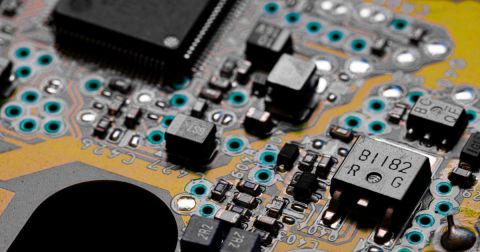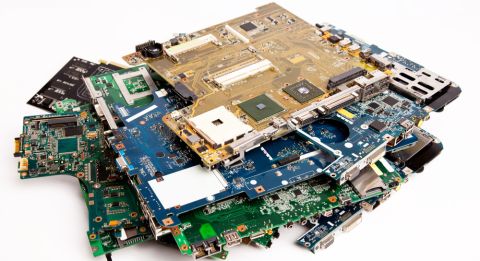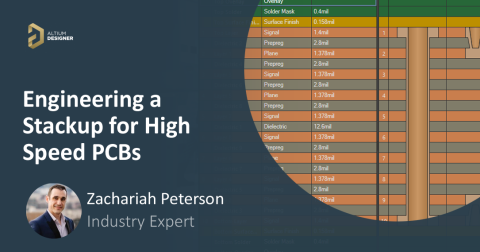Propagation Delay Calculators in High-Speed PCB Design

Propagation delay becomes an important consideration in high-speed PCB design. You’ll need to make sure that your signals remain synchronized throughout your board in order to prevent skew. A PCB design package that incorporates a propagation delay calculator as part of your design rules makes it easy to compensate for propagation delay, allowing you to focus on routing and signal integrity, rather than manually adjusting traces and calculating tolerances.
ALTIUM DESIGNER
A heavily rules-driven PCB design platform with advanced routing and simulation features.
So you’ve decided that you’ll be including components with reasonably fast rise time and switching speed in your next PCB. So how do you ensure that your components will behave properly during operation? No one has time to order and reorder test boards just to check their design. Your PCB design software should give you the tools to validate your next high-speed design before you place your manufacturing order.
Working with high-speed devices requires accounting for a number of design aspects. Some designers don’t think about what happens to signals in high-speed circuits, and most classes don’t teach this behavior explicitly, but high-speed PCB design requires very tight routing tolerances. Propagation delay in your traces can quickly cause signals to desynchronize, and your PCB design software should incorporate a propagation delay calculator into your design rules so that you can easily compensate for propagation delay and prevent skew.
Propagation Delay in High-Speed Design
Propagation delay arises due to the finite speed of digital signals in your PCB. Calculating propagation delay in a trace requires knowledge of the effective dielectric constant in your traces. Once a trace becomes long enough and the switching speed in your device is high, your device will transition to high-speed behavior, and you will need to make sure traces in a signal net are properly tuned to compensate for propagation delay.
If some traces in a signal net are appreciably longer than others, signals in your high-speed PCB will be out of sync, and your information will not transmit across your board correctly. Signals will arrive at their destinations at incorrect times, and you’ll need to add some extra length to your shorter traces to compensate. Calculating propagation delay is really about ensuring that trace lengths are maintained within a certain tolerance. Your routing tools in your PCB design software should interface with your design rules, making it easy to compensate for propagation delay.
Great CAD and Simulation Tools Make High-Speed Design Easy
Properly sizing the right trace length in order to compensate for propagation delay and prevent skew can quickly cause your device to transition to high-speed behavior, and high-speed routing strategies should be incorporated into your PCB if propagation delay is a real concern. Great PCB design software can help you work within these requirements quite easily, helping you avoid major signal integrity problems that can cripple your next PCB.
Instead of searching online for a propagation delay calculator and manually adjusting trace lengths in a high-speed device, your PCB design software should incorporate these calculations as part of your design rules and allow you to insert meanders into your traces. This allows you to focus on routing your high-speed signals around your board instead of running repetitive propagation delay calculations.
- Your routing strategy can make or break your next high-speed design. Choosing the right routing strategy and stackup can help you route the traces you need while preventing desynchronization due to propagation delay. Learn more about routing strategies in high-speed design.
- Your board stackup has an important effect on noise, EMC, and the routing strategy in your next high-speed device. Learn more about choosing the right stackup for your next high-speed device.
- Simulation and analysis tools are essential for validating the functionality of your next high speed.
Learn more about signal integrity simulations in high-speed design.
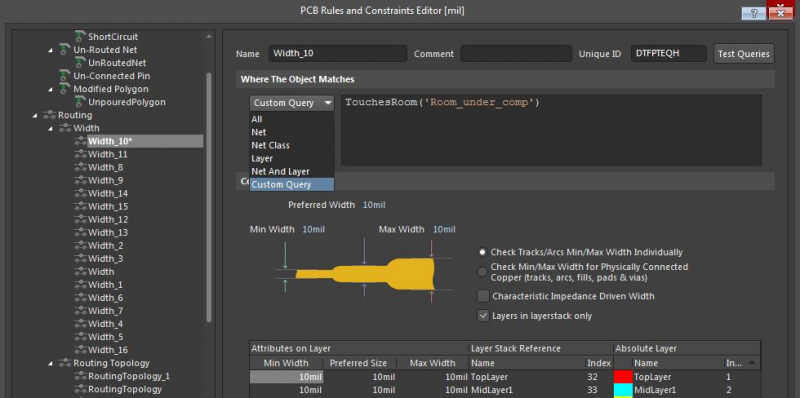
Sizing traces as design rules in Altium Designer
Validating Your Design
Creating PCBs for high-speed applications is all about the right routing strategies. Crosstalk between signal traces, ringing due to termination problems, and a variety of coupling effects throughout a PCB can be solved with the right routing and stackup strategies. Your PCB design software needs to include all the right tools that allow you to build the layer stackup you need and quickly route traces in your layout while checking against your design rules.
Validating your PCB takes simulation and analysis tools that access your design data directly from your PCB layout. Your CAD data needs to feed directly into your simulation and analysis tools if you want to quickly validate the functionality of your device, especially with high-speed devices. Your CAD tools also need to have high-level routing features that interface directly with your design rules, allow you to define the geometry of your differential pairs, and ensure synchronization among traces in your signal nets and input or output models.
Using Design Rules to Compensate Propagation Delay
High-speed design and complicated routing requirements tend to go hand-in-hand. Your CAD tools should help you automate routing throughout your board while still being adaptable to any routing strategy. When it comes time to validate your board against design rules and check signal integrity, the information in your layout should interface directly with your simulation and analysis tools. You’ll need to make sure that your interconnects are terminated properly and that trace lengths are sized properly in order to compensate for propagation delay.
When your propagation delay calculator is incorporated as part of your design rules, you’ll be able to check that your trace lengths are within the proper tolerance level without measuring traces manually in your CAD tools. Autorouter tools that are built into this environment make it easy to adjust trace lengths in a net so that skew is minimized, ensuring that your signals always remain synchronized.
- High-speed design is all about maintaining signal integrity. Signal integrity analysis can become part of the design process when you use powerful PCB design software.
Learn more about incorporating signal integrity as part of PCB design.
- Compensating propagation delay and preventing skew becomes easy when you use an autorouter that interfaces with your design rules. Learn more about preventing skew with an autorouter.
- Great design software will allow your design tools to integrate with your rules-checking features, allowing you to validate your device before you begin manufacturing.
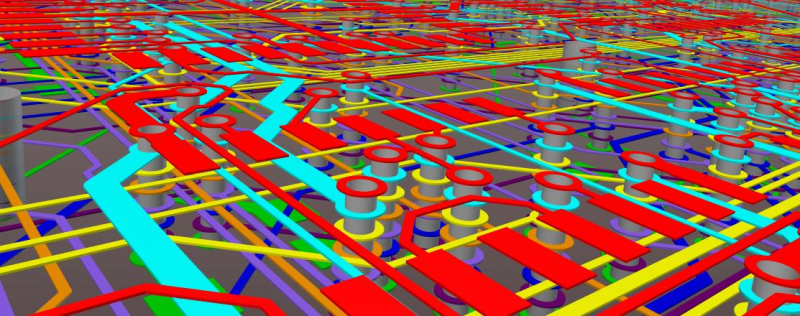
3D view of trace routing in a multi-layer PCB.
The Unified Environment in Altium Designer
Software that combines rules-checking features and ultra-accurate CAD tools provides a huge productivity boost. This allows you to automatically calculate and compensate propagation delay in your PCB without manually measuring traces with your CAD tools. So what is the best way to bundle all of these features into a single program and ensure they can communicate with each other properly?
Whether counting propagation time, delay measurement, time delay, or time frame - only Altium Designer packages all of these critical PCB design tools into a single, unified interface. The rules-driven design engine in Altium Designer ensures that all of your layout and routing tools communicate in the same language. Your design tools will prevent basic input and output errors when they interface directly with your design rules.
Designing in a Unified Environment
The routing tools in Altium Designer give you the freedom to execute the routing strategy that you know is best for your device, or you can allow the program to route your traces automatically. You’ll be able to do everything from define differential pairs and signal nets to build a custom routing profile that facilitates dense component placement, ensuring your devices have a competitive edge.
Altium Designer’s routing tools also make it easy to compensate for propagation time, propagation delay, and delay measurement, as well as avoiding skew. These calculations are built into the design rules, making it easy to check your design against standard rules. If you need to adjust your trace lengths to eliminate skew due to propagation delay, the routing tools make it easy to meander your shorter traces in a signal net. You can be sure your signals are synchronized when you use Altium Designer.
- The propagation delay and switching speed in your high-speed PCB can be used to define trace length tolerances as a design rule. Altium Designer’s autorouter feature works within these design rules, ensuring that your signals are always synchronized. Learn more about the rules-driven design engine in Altium Designer.
- Routing your next PCB is much easier when you use a routing tool that interfaces directly with your design rules. Learn more about the interactive routing tools in Altium Designer.
- There’s much more to high-speed design than just signal synchronization. Learn more about high-speed design in Altium Designer.
If you’re tired of working with an external calculator and you want to reclaim your time and sanity, then you need to work in a unified design environment. Altium Designer is the only unified, rules-driven platform that includes top-notch CAD, routing, and simulation in a single package.
Any new piece of software takes time to learn, especially if the software company leaves you to learn on your own. Altium Designer gives you access to useful design examples, the AltiumLive forum, an extensive knowledge base, and podcasts and webinars served by industry experts. Altium Designer truly wants you to be successful.
The best design, routing, and simulation tools can help you compensate for propagation delay in your next high-speed device. Rather than working with an external propagation delay calculator, a unified platform like Altium Designer is the best way to incorporate these calculations as part of the design process. If you’re ready for a new type of PCB design platform, then you need to try Altium Designer.


